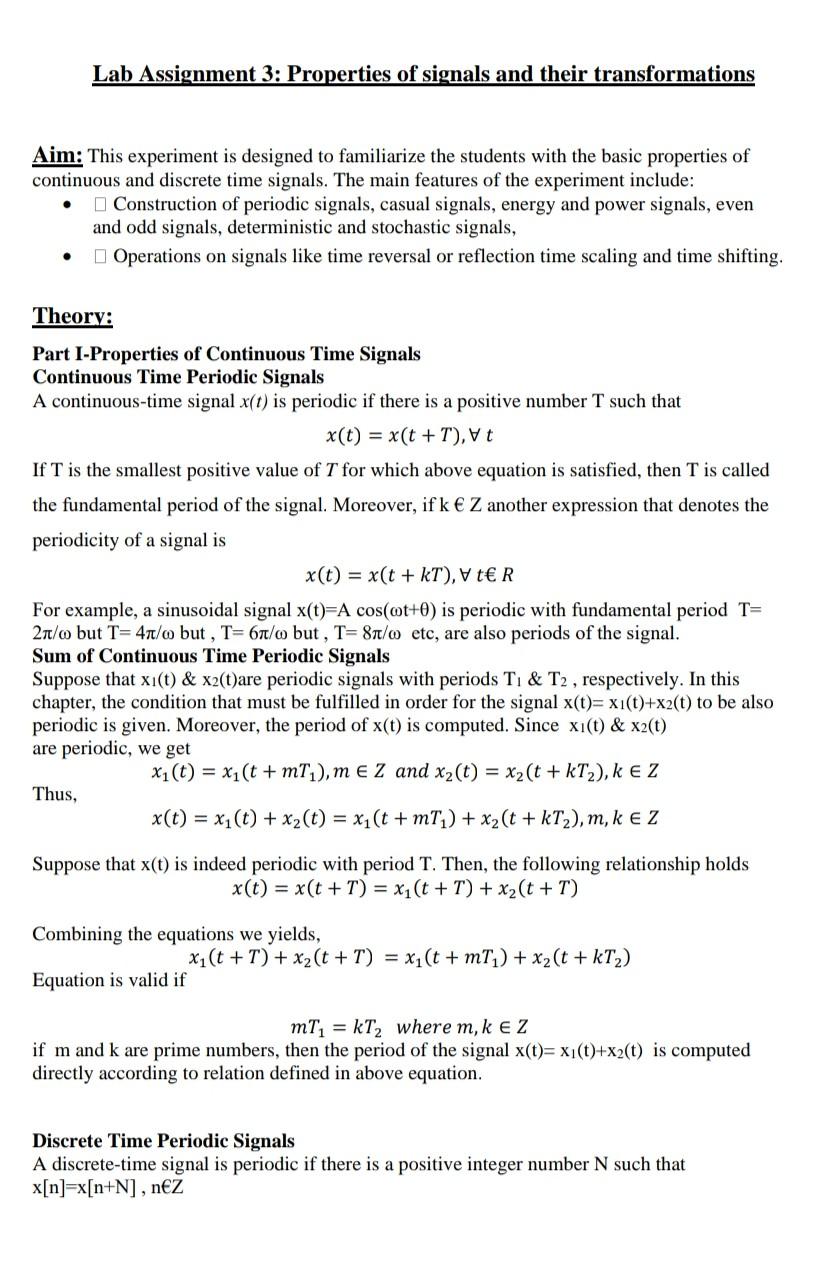Answered step by step
Verified Expert Solution
Question
1 Approved Answer
code for following Lab Assignment 3: Properties of signals and their transformations Aim: This experiment is designed to familiarize the students with the basic properties

code for following
Lab Assignment 3: Properties of signals and their transformations Aim: This experiment is designed to familiarize the students with the basic properties of continuous and discrete time signals. The main features of the experiment include: Construction of periodic signals, casual signals, energy and power signals, even and odd signals, deterministic and stochastic signals, Operations on signals like time reversal or reflection time scaling and time shifting, . . Theory: Part I-Properties of Continuous Time Signals Continuous Time Periodic Signals A continuous-time signal x(t) is periodic if there is a positive number T such that x(t) = x(t +T), Vt If T is the smallest positive value of T for which above equation is satisfied, then T is called the fundamental period of the signal. Moreover, if k Z another expression that denotes the periodicity of a signal is x(t) = x(t + KT), V t R For example, a sinusoidal signal x(t)=A cos(ot+0) is periodic with fundamental period T= 21/o but T=4nt/o but , T=67/o but , T=81/o etc, are also periods of the signal. Sum of Continuous Time Periodic Signals Suppose that xi(t) & x2(t)are periodic signals with periods T. & T2, respectively. In this chapter, the condition that must be fulfilled in order for the signal x(t)=xi(t)+x2(t) to be also periodic is given. Moreover, the period of x(t) is computed. Since xi(t) & x2(t) are periodic, we get xi(t) = x1(t + mt.), m e Z and xz(t) = x2(t + kT2), k E Z Thus, x(t) = x1(t) + x2(t) = x1(t + mt.) + x2(t+kT2), m, k ez Suppose that x(t) is indeed periodic with period T. Then, the following relationship holds x(t) = x(t + T) = x1(t + T) + x2(t+T) Combining the equations we yields, xi(t +T) + x2(t +T) = x1(t + mt) + x2(t+kT2) Equation is valid if ml = kT2 where m, k ez if m and k are prime numbers, then the period of the signal x(t)= x1(t)+x2(t) is computed directly according to relation defined in above equation. Discrete Time Periodic Signals A discrete-time signal is periodic if there is a positive integer number N such that x[n]=x[n+N], nez Lab Assignment 3: Properties of signals and their transformations Aim: This experiment is designed to familiarize the students with the basic properties of continuous and discrete time signals. The main features of the experiment include: Construction of periodic signals, casual signals, energy and power signals, even and odd signals, deterministic and stochastic signals, Operations on signals like time reversal or reflection time scaling and time shifting, . . Theory: Part I-Properties of Continuous Time Signals Continuous Time Periodic Signals A continuous-time signal x(t) is periodic if there is a positive number T such that x(t) = x(t +T), Vt If T is the smallest positive value of T for which above equation is satisfied, then T is called the fundamental period of the signal. Moreover, if k Z another expression that denotes the periodicity of a signal is x(t) = x(t + KT), V t R For example, a sinusoidal signal x(t)=A cos(ot+0) is periodic with fundamental period T= 21/o but T=4nt/o but , T=67/o but , T=81/o etc, are also periods of the signal. Sum of Continuous Time Periodic Signals Suppose that xi(t) & x2(t)are periodic signals with periods T. & T2, respectively. In this chapter, the condition that must be fulfilled in order for the signal x(t)=xi(t)+x2(t) to be also periodic is given. Moreover, the period of x(t) is computed. Since xi(t) & x2(t) are periodic, we get xi(t) = x1(t + mt.), m e Z and xz(t) = x2(t + kT2), k E Z Thus, x(t) = x1(t) + x2(t) = x1(t + mt.) + x2(t+kT2), m, k ez Suppose that x(t) is indeed periodic with period T. Then, the following relationship holds x(t) = x(t + T) = x1(t + T) + x2(t+T) Combining the equations we yields, xi(t +T) + x2(t +T) = x1(t + mt) + x2(t+kT2) Equation is valid if ml = kT2 where m, k ez if m and k are prime numbers, then the period of the signal x(t)= x1(t)+x2(t) is computed directly according to relation defined in above equation. Discrete Time Periodic Signals A discrete-time signal is periodic if there is a positive integer number N such that x[n]=x[n+N], nezStep by Step Solution
There are 3 Steps involved in it
Step: 1

Get Instant Access to Expert-Tailored Solutions
See step-by-step solutions with expert insights and AI powered tools for academic success
Step: 2

Step: 3

Ace Your Homework with AI
Get the answers you need in no time with our AI-driven, step-by-step assistance
Get Started


